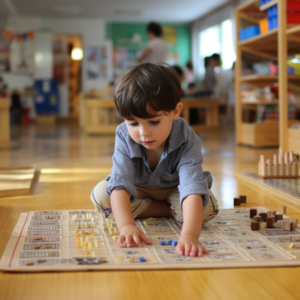Bringing the Montessori method into your home can be a transformative experience for both you and your child. As an educator and firm believer in the Montessori approach, I am excited to share practical tips on how to create a Montessori-inspired environment at home. By embracing this child-centered approach, you can foster independence, curiosity, and a love for learning in your child’s everyday life.
- Preparing the Environment: A Child-Centric Space
Designate a specific area in your home as a Montessori-inspired space. Organize it with child-sized furniture, open shelves, and engaging learning materials. This environment will encourage your child to explore, make choices, and develop autonomy. - Practical Life Skills: Nurturing Independence
Introduce practical life activities into your daily routine, such as pouring water, buttoning clothes, or sweeping. These activities not only foster independence but also enhance fine motor skills and concentration. - Montessori Toys and Materials: Quality Over Quantity
Select Montessori-approved toys and materials that promote hands-on exploration and problem-solving. Quality, open-ended toys can stimulate your child’s imagination and creativity. - Follow the Child’s Interests: Child-Led Learning
Observe your child’s interests and provide materials that align with their curiosity. Allow them to lead their learning journey, exploring topics that captivate their attention. - Freedom within Limits: Setting Boundaries
Create a safe and structured environment by setting gentle boundaries. Offer choices within reasonable limits, allowing your child to develop decision-making skills and self-discipline. - Encouraging Independence: Everyday Activities
Involve your child in everyday activities, such as preparing meals or tidying up. These experiences promote confidence, responsibility, and a sense of contribution to the family. - Foster a Love for Nature: Outdoor Exploration
Spend time outdoors with your child, exploring nature and discovering its wonders. Nature walks, gardening, and outdoor play provide valuable sensory experiences and opportunities for learning. - Nurture the Senses: Sensory Play and Exploration
Incorporate sensory play into your child’s day, such as water play, sand activities, or nature-based sensory bins. Sensory exploration supports brain development and enhances cognitive skills. - Embrace Uninterrupted Play: Respectful Observations
Allow your child uninterrupted playtime, providing them the freedom to concentrate and explore without interruption. Respectful observations will help you better understand their needs and interests.
Conclusion:
Bringing Montessori into your home is a beautiful journey of discovery and growth for both you and your child. By creating an environment that encourages independence, nurtures curiosity, and respects the child’s innate abilities, you can lay a strong foundation for lifelong learning and a deep love for exploration. Embrace the principles of Montessori in your home, and watch your child flourish as a confident, self-directed, and joyful learner.

